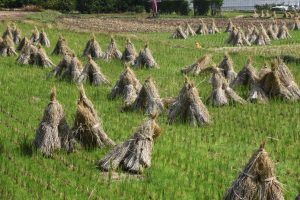In fiscal year 2020, Japan’s calorie-based food self-sufficiency rate matched the record low of 37 percent. The same year, Japan’s food self-sufficiency rate was 67 percent on a production value basis. The Ministry of Agriculture, Forestry, and Fisheries (MAFF) has long argued that Japan should produce more food by itself.
However, is this concept really appropriate to describe the country’s challenge in food and agricultural industry?
The United Nations’ Food and Agricultural Organization (FAO) defines food self-sufficiency as “the extent to which a country can satisfy its food needs from its own domestic production.” The food self-sufficiency rate of certain food items thus means the amount of domestic production divided by supplies needed for domestic consumption.
FAO conceptualizes that food availability, food access, utilization, and stability are all components of food security. According to Japan’s Ministry of Foreign Affairs (MOFA), the calorie-based food self-sufficiency rate is an indicator for the country’s food availability.
Japan’s Food, Agriculture, and Rural Areas Basic Act explains that a stable food supply is fundamental to the country and must be secured mainly through “increased domestic agricultural production,” as “the world’s food supply and demand and trade have some uncertainties.”
It is true that Japan’s calorie-based food self-sufficiency rate has declined over time. In 1960, Japan covered most of its domestic consumption by itself – the rate was 102 percent for rice, 100 percent for fruits and vegetables, and 91 percent for meats.
Today, Japan depends on imports for many food items. In 2021, while Japan domestically produced 98 percent of rice consumed, the rate was 30 percent for fruits, 76 percent for vegetables, and 16 percent for stock farm products. The rates for other food items were 21 percent for soy beans, 15 percent for wheat, and 11 percent for beef.
In 2018, MAFF calculated the calorie-based food self-sufficiency rate for other countries such as the United States (132 percent), Canada (266 percent), and France (125 percent). Referring to this estimate, MAFF has repeatedly expressed their concern about Japan’s low food self-sufficiency rate.
In the latest 2020 Basic Plan for Food, Agriculture and Rural Areas, MAFF set goals to pull the country’s self-sufficiency rate up to 45 percent on a calorie basis and 75 percent on a production value basis by 2030.
The MAFF plan ambitiously aims to increase the proportion of domestic production of wheat by 40 percent, soy beans by 60 percent, vegetables by 15 percent, and feed by 48 percent. The plan intends to introduce high-yield or disease-resistant new varieties for many crops to achieve these goals.
However, the feasibility of these goals is highly doubtful. The production rate for these food items has been on the decline recently. Development and introduction of new crop varieties takes time. The industry’s rapid decrease in workers and farmlands exceeds the impact of new technologies.
Japan is losing 50,000 workers in the industry per year and has less than one-third of the agricultural population compared to 1980. Yet the supply to demand food self-sufficiency rate does not consider these essential background factors for the country’s food production.
Indeed, it is often difficult to properly understand the situation by using the food self-sufficiency rate alone. For example, developing countries with limited access to diverse food items generally have a high food self-sufficiency rate. Is that really better for their people?
To consider these complexities, MAFF recently introduced a food self-sufficiency potential indicator referring to “calories of food that can be obtained by fully utilizing Japan’s potential production capacity.” In other words, this estimate shows how much food Japan could produce for its citizens at most.
According to this estimate, Japan cannot satisfy the current eating habits of its citizens based on its available farmlands and human resources. To provide the estimated energy requirement (EER) of 2,168 kcal for all citizens in Japan, the country would have to radically transform its farmlands to grow tubers and roots.
The 2020 estimate of the food self-sufficiency potential indicator showed that the decrease in farmlands overshadowed an increase in productivity. If rice and wheat are the most-planted crops, Japan can only provide 1,759 kcal, below the EER, to its citizens through domestic production.
Despite some impracticalities, such as the fact that the proposed farmland transformation would actually take a long time, this new potential indicator, taking various agricultural resources into account, provides a viewpoint overlooked by the food self-sufficiency rate debate.
The key point is that Japan’s weakening agricultural sector – marked by decreases in both agricultural workers and farmlands – is threatening the country’s food security at a time when Japan wants to feed itself. However, the MAFF plan sets no specific goal for these crucial elements.
To summarize, looking at the food self-sufficiency rate alone cannot describe the challenge Japan faces in its quest to ensure comprehensive food security. To achieve this goal, rather than simply aiming to increase a certain ratio, Japan should commit to strengthen its fundamental capacity for agricultural production.

































